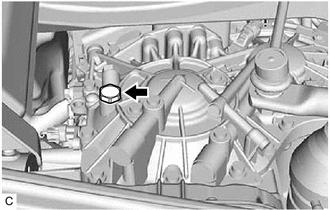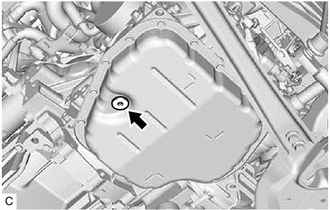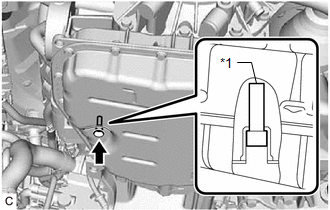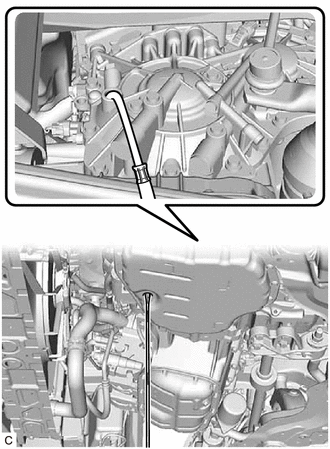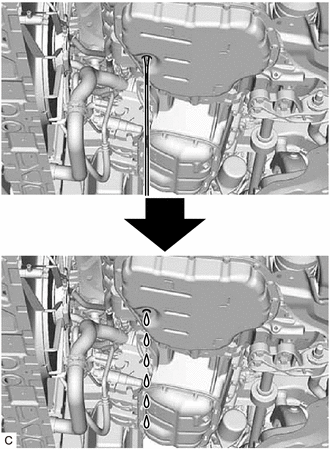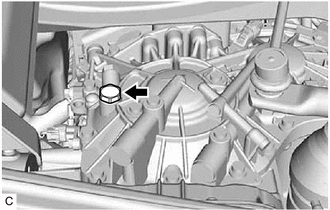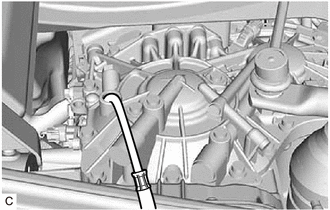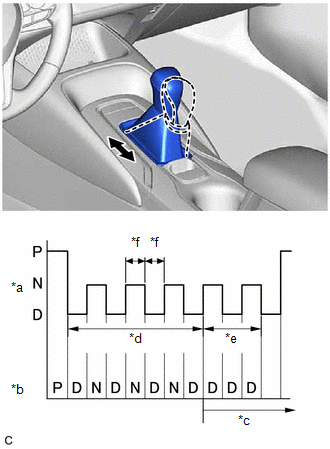- Repair of a fluid leak, etc.
- Replacement of the continuously variable transaxle assembly with torque converter assembly to a new one.
| Last Modified: 05-13-2024 | 6.11:8.1.0 | Doc ID: RM100000001GVVV |
| Model Year Start: 2020 | Model: Corolla Hatchback | Prod Date Range: [01/2019 - 11/2022] |
| Title: K313 (CVT): CONTINUOUSLY VARIABLE TRANSAXLE FLUID: ADJUSTMENT; 2020 - 2023 MY Corolla Corolla Hatchback [01/2019 - 11/2022] | ||
ADJUSTMENT
CAUTION / NOTICE / HINT
The necessary procedures (adjustment, calibration, initialization or registration) that must be performed after parts are removed and installed, or replaced during CVT fluid adjustment are shown below.
Necessary Procedure After Parts Removed/Installed/Replaced
|
Replacement Part or Procedure |
Necessary Procedure |
Effect/Inoperative Function when Necessary Procedure not Performed |
Link |
|---|---|---|---|
|
Replacement of CVT fluid |
ATF thermal degradation estimate reset |
The value of the Data List item "ATF Thermal Degradation Estimate" is not estimated correctly |
PROCEDURE
1. PRECAUTIONS AND WORK DESCRIPTION
(a) The K313 continuously variable transaxle assembly does not have an oil filler tube or oil level gauge. When adding fluid, add fluid through the refill hole in the continuously variable transaxle assembly. The fluid level can be adjusted by draining excess fluid (allowing excess fluid to overflow) through the overflow (CVT) tube of the transaxle oil (CVT) pan sub-assembly.
HINT:
"Overflow" indicates the condition under which fluid comes out of the overflow plug hole.
(b) When adding fluid, add the specified amount of fluid while the engine assembly is cold. Then, warm up the engine assembly to circulate the fluid in the continuously variable transaxle assembly and adjust the fluid level with the engine idling at the specified fluid temperature.
(c) The K313 continuously variable transaxle assembly requires Toyota Genuine CVT fluid FE.
(d) When adjusting the fluid level, park the vehicle on level ground (make sure that the tilt angle from the front to rear and side to side of the vehicle is within +/-1°).
(e) When adjusting the fluid level, turn off all electrical systems, such as the air conditioning, lighting system, electric fan and audio system, to reduce load.
(f) The fluid temperature shown in the text is "A/T Oil Temperature No.1" displayed on the Techstream.
(g) Fluid level adjustment should be performed according to the following procedure and notes.
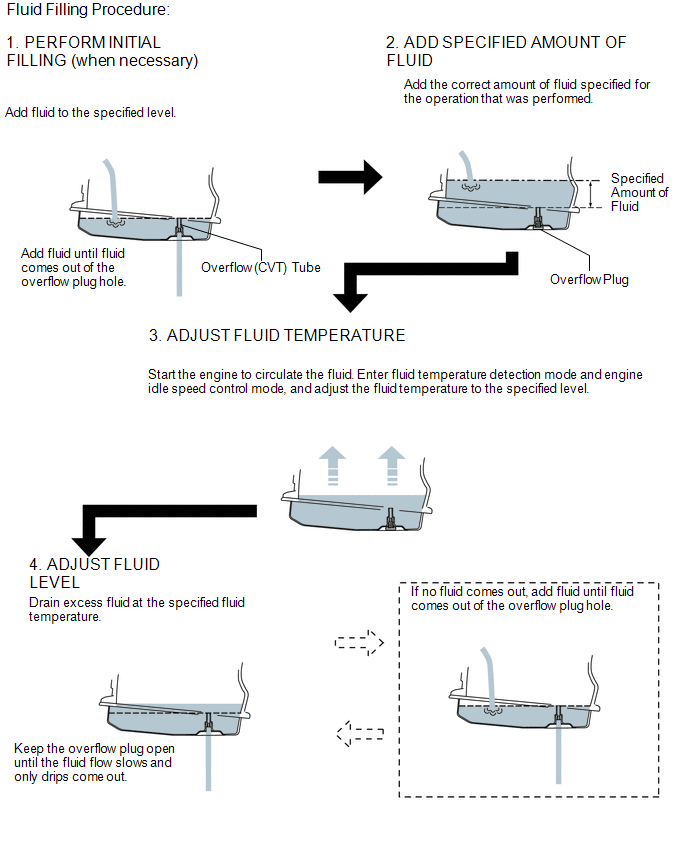
2. WORK FLOW
(a) The adjustment should be performed according to the procedures referenced in the work flow below.
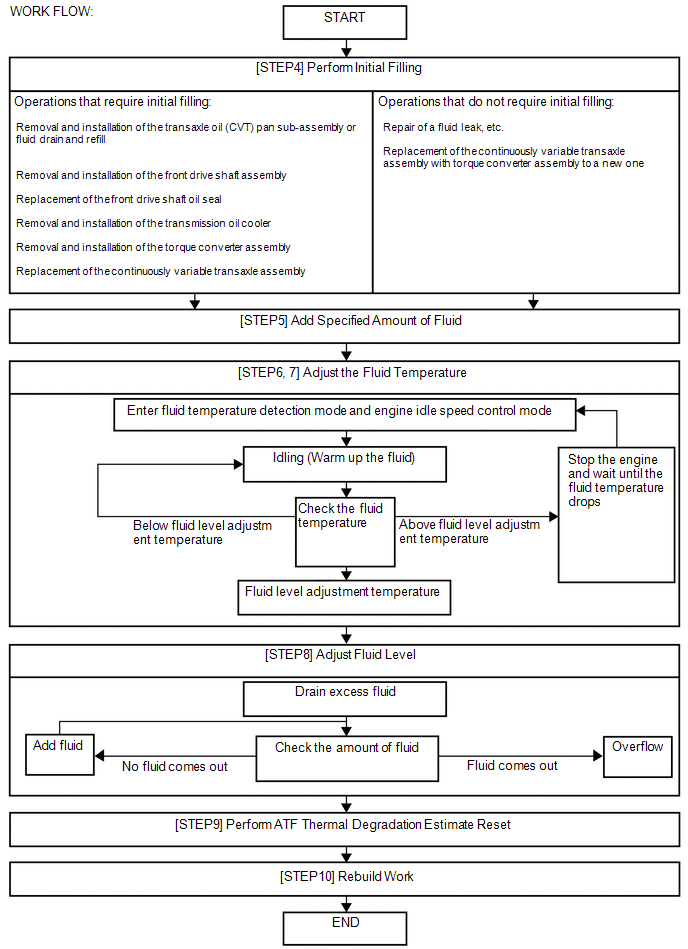
3. PREPARATION WORK
NOTICE:
If the continuously variable transaxle assembly is hot (fluid temperature is high), wait until the fluid temperature becomes the same as the ambient temperature before starting the following procedure (recommended fluid temperature: approximately 20°C (68°F)).
(a) Lift the vehicle.
NOTICE:
Set the vehicle on a lift so that the vehicle is kept level when it is lifted up (make sure that the tilt angle from the front to rear and side to side of the vehicle is within +/-1°).
(b) Remove the No. 1 engine under cover assembly.
(c) Remove the rear engine under cover LH.
4. PERFORM INITIAL FILLING
NOTICE:
After performing either of the following operations, it is not necessary to perform the initial filling procedure. Proceed to the Add Specified Amount of Fluid procedure (Step 5).
|
Operations that do not Require Initial Filling |
|---|
|
|
|
(a) Remove the refill plug and gasket from the rear transaxle case. |
|
|
(b) Using a 6 mm hexagon socket wrench, remove the overflow plug and gasket from the transaxle oil (CVT) pan sub-assembly. NOTICE:
|
|
|
(c) Using a 6 mm hexagon socket wrench, check that the overflow (CVT) tube is tightened to the specified torque. Torque: 1.7 N·m {17 kgf·cm, 15 in·lbf} NOTICE: If the overflow (CVT) tube is not tightened to the specified torque, the amount of fluid cannot be precisely adjusted. HINT: To check the torque of the overflow (CVT) tube, insert a 6 mm hexagon socket wrench into the overflow plug hole. |
|
(d) Perform initial filling.
|
(1) Add fluid to the refill hole until it flows out of the overflow plug hole. NOTICE: Use Toyota Genuine CVT fluid FE. |
|
|
(e) Wait until the fluid flow slows and only drips come out. |
|
|
(f) Using a 6 mm hexagon socket wrench, temporarily install the overflow plug and gasket to the transaxle oil (CVT) pan sub-assembly. HINT: Reuse the old gasket as the overflow plug will be removed again to adjust the fluid level. |
|
|
(g) Temporarily install the refill plug and gasket to the rear transaxle case. HINT: Reuse the old gasket as the refill plug will be removed again to adjust the fluid level. |
|
5. ADD SPECIFIED AMOUNT OF FLUID
|
(a) Remove the refill plug and gasket from the rear transaxle case. |
|
|
(b) Add fluid to the refill hole using the correct amount of fluid as listed in the table below. NOTICE: Use Toyota Genuine CVT fluid FE. HINT: The refill amount differs depending on the operation that was performed. Standard Capacity
|
|
|||||||||||||||||||||||||||||
|
(c) Temporarily install the refill plug and gasket to the rear transaxle case to avoid fluid spillage. HINT: Reuse the old gasket as the refill plug will be removed again to adjust the fluid level. |
|
(d) Lower the vehicle.
6. ADJUST FLUID TEMPERATURE (when Using the Techstream)
(a) Connect the Techstream to the DLC3 with the ignition switch off.
(b) Turn the ignition switch to ON and turn the Techstream on.
NOTICE:
To reduce load, make sure that all electrical systems, such as the air conditioning, lighting system, electric fans and audio system, are off.
(c) Enter the following menus: Powertrain / Transmission / Active Test / Activate the TC Terminal.
Powertrain > Transmission > Active Test
|
Active Test Display |
|---|
|
Activate the TC Terminal |
|
Data List Display |
|---|
|
A/T Oil Temperature No.1 |
(d) According to the display on the Techstream, perform the Active Test "Activate the TC Terminal / ON".
HINT:
The indicator lights on the combination meter blink to indicate that a DTC has been stored when the Active Test "Activate the TC Terminal / ON" is performed.
(e) Select the Data List item: A/T Oil Temperature No.1.
(f) Depress and hold the brake pedal.
(g) Start the engine.
NOTICE:
To reduce load, make sure that all electrical systems, such as the air conditioning, lighting system, electric fan and audio system, are off.
(h) Slowly move the shift lever from P to D, and then back to P (keep the shift lever in each position for approximately 3 seconds).
HINT:
Slowly move the shift lever to circulate the fluid through each part of the continuously variable transaxle assembly.
|
(i) While observing the D shift indicator on the combination meter, move the shift lever back and forth between N and D at an interval of less than 1.5 seconds for 6 seconds or more. NOTICE: Do not pause for 1.5 seconds or more. HINT: Performing this operation will cause the vehicle to enter fluid temperature detection mode. |
|
(j) Check that the D shift indicator comes on for 2 seconds.

|
*A |
Type A |
*B |
Type B |
HINT:
- When fluid temperature detection mode is activated, the D shift indicator on the combination meter comes on for 2 seconds.
- If the D shift indicator does not come on for 2 seconds, return to the first step (perform the Active Test "Activate the TC Terminal / ON") and perform the procedure again.
(k) Move the shift lever to P.
(l) Release the brake pedal.
(m) According to the display on the Techstream, perform the Active Test "Activate the TC Terminal / OFF".
NOTICE:
Make sure that terminals are not connected. If the terminals are connected, the fluid level cannot be precisely adjusted due to fluctuations in engine speed.
HINT:
- Disconnecting the terminals activates engine idle speed control mode.
- In engine idle speed control mode, engine idle speed control starts when the fluid temperature reaches the specified temperature and the engine speed is maintained.
- Even after the terminals are disconnected, fluid temperature detection mode remains active until the ignition switch is turned off.
(n) Adjust the fluid temperature to the fluid level adjustment temperature.
(1) Check the fluid temperature by monitoring the D shift indicator.
Relationship between Fluid Level Adjustment Temperature and D Shift Indicator:
|
Below Fluid Level Adjustment Temperature |
Fluid Level Adjustment Temperature |
Above Fluid Level Adjustment Temperature |
|
|---|---|---|---|
|
Fluid Temperature ("A/T Oil Temperature No.1" displayed on the Techstream) |
35°C (95°F) or less |
35 to 45°C (95 to 113°F) |
45°C (113°F) or more |
|
D Shift Indicator |
Off |
On |
Blinks |
HINT:
- In fluid temperature detection mode, the D shift indicator comes on, goes off, or blinks depending on the fluid temperature.
- The fluid filling procedure should be performed when the D shift indicator is on (the fluid temperature is within the fluid level adjustment temperature range).
(2) If the D shift indicator is on [Fluid Level Adjustment Temperature: 35 to 45°C (95 to 113°F)]: Immediately proceed to the Adjust Fluid Level (Step 8).
(3) Adjust the fluid temperature.
- If the D shift indicator is off [Below Fluid Level Adjustment Temperature: 35°C (95°F) or less]: Warm up the engine with the engine idling in engine idle speed control mode until the D shift indicator turns on.
- If the D shift indicator is on [Fluid Level Adjustment Temperature: 35 to 45°C (95 to 113°F)]: Immediately proceed to Adjust Fluid Level (Step 8).
- If the D shift indicator is blinking [Above Fluid Level Adjustment Temperature: 45°C (113°F) or more]: Stop the engine and wait until the fluid temperature drops to 35°C (95°F) or less (the D shift indicator goes off). Then perform the adjust fluid temperature procedure again from the beginning.
7. ADJUST FLUID TEMPERATURE (when Not Using the Techstream)
(a) Turn the ignition switch off.
(b) Depress and hold the brake pedal.
(c) Turn the ignition switch to ON and start the engine. [#1]
NOTICE:
To reduce load, make sure that all electrical systems, such as the air conditioning, lighting system, electric fan and audio system, are off.
(d) Slowly move the shift lever from P to D, and then back to P (keep the shift lever in each position for approximately 3 seconds). [#2]
HINT:
Slowly move the shift lever to circulate the fluid through each part of the continuously variable transaxle assembly.
|
(e) While observing the D shift indicator on the combination meter, move the shift lever back and forth between N and D at an interval of less than 1.5 seconds for 12 seconds or more. [#3] NOTICE: Do not pause for 1.5 seconds or more. HINT:
|
|
(f) Check that the D shift indicator comes on for 2 seconds.
HINT:
- When fluid temperature detection mode is activated, the D shift indicator on the combination meter comes on for 2 seconds.
- If the D shift indicator does not come on for 2 seconds, return to the first step (Turn the ignition switch to ON and start the engine. [#1]) and perform the procedure again.
- Fluid temperature detection mode is active until the ignition switch is turned off.

|
*A |
Type A |
*B |
Type B |
(g) Move the shift lever to P.
(h) Release the brake pedal.
(i) Adjust the fluid temperature to the fluid level adjustment temperature.
(1) Check the fluid temperature by monitoring the D shift indicator.
Relationship between Fluid Level Adjustment Temperature and D Shift Indicator:
|
Below Fluid Level Adjustment Temperature |
Fluid Level Adjustment Temperature |
Above Fluid Level Adjustment Temperature |
|
|---|---|---|---|
|
Fluid Temperature ("A/T Oil Temperature No.1" displayed on the Techstream) |
35°C (95°F) or less |
35 to 45°C (95 to 113°F) |
45°C (113°F) or more |
|
D Shift Indicator |
Off |
On |
Blinks |
HINT:
- In fluid temperature detection mode, the D shift indicator comes on, goes off, or blinks depending on the fluid temperature.
- The fluid filling procedure should be performed when the D shift indicator is on (the fluid temperature is within the fluid level adjustment temperature range).
(2) If the D shift indicator is on [Fluid Level Adjustment Temperature: 35 to 45°C (95 to 113°F)]: Immediately proceed to the Adjust Fluid Level (Step 8).
(3) Adjust the fluid temperature.
- If the D shift indicator is off [Below Fluid Level Adjustment Temperature: 35°C (95°F) or less]: Warm up the engine with the engine idling in engine idle speed control mode until the D shift indicator turns on.
- If the D shift indicator is on [Fluid Level Adjustment Temperature: 35 to 45°C (95 to 113°F)]: Immediately proceed to Adjust Fluid Level (Step 8).
- If the D shift indicator is blinking [Above Fluid Level Adjustment Temperature: 45°C (113°F) or more]: Stop the engine and wait until the fluid temperature drops to 35°C (95°F) or less (the D shift indicator goes off). Then perform the adjust fluid temperature procedure again from the beginning.
8. ADJUST FLUID LEVEL
CAUTION:
-
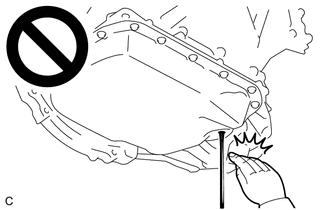 Make sure not to get any of the drained fluid on your hands, etc.
Make sure not to get any of the drained fluid on your hands, etc.
- The high temperature of the drained fluid could cause burns.
-
When working near the engine room while the engine has started or the ignition switch is ON, do not touch the rotating components such as the V-ribbed belt or cooling fan.
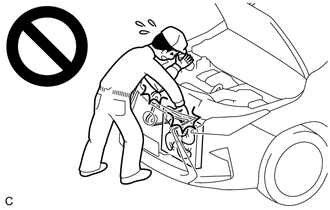
- Touching the rotating components such as the V-ribbed belt or cooling fan could result in your hand or clothing getting caught and pulled in.
(a) Lift the vehicle.
NOTICE:
Set the vehicle on a lift so that the vehicle is kept level when it is lifted up (make sure that the tilt angle from the front to rear and side to side of the vehicle is within +/-1°).
|
(b) Using a 6 mm hexagon socket wrench, remove the overflow plug and gasket from the transaxle oil (CVT) pan sub-assembly. CAUTION: Be careful as the fluid coming out of the overflow plug hole is hot. |
|
(c) Check the amount of fluid that comes out of the overflow plug hole.
- If the amount of fluid that comes out of the overflow plug hole is large, proceed to step [#1].
- If no fluid comes out of the overflow plug hole, proceed to step [#2].
NOTICE:
If only a small amount of fluid (approximately 5 cc) comes out of the overflow plug hole, then only fluid remaining in the overflow (CVT) tube has come out. This condition is not considered as overflow, so it is necessary to add fluid.
(d) If the amount of fluid that comes out of the overflow plug hole is large. [#1]
|
(1) Wait until the fluid flow slows and only drips come out. HINT: The fluid flow will not stop completely because the fluid continues to expand as its temperature increases. |
|
(e) If no fluid comes out of the overflow plug hole. [#2]
|
(1) Remove the refill plug and gasket from the rear transaxle case. |
|
|
(2) Then add fluid through the refill hole until fluid comes out of the overflow plug hole. NOTICE: Use Toyota Genuine CVT fluid FE. |
|
|
(3) Wait until the fluid flow slows and only drips come out. HINT: The fluid flow will not stop completely because the fluid continues to expand as its temperature increases. |
|
|
(f) Using a 6 mm hexagon socket wrench, install the overflow plug and a new gasket to the transaxle oil (CVT) pan sub-assembly. Torque: 40 N·m {408 kgf·cm, 30 ft·lbf} |
|
|
(g) Install the refill plug and a new gasket to the rear transaxle case. Torque: 49 N·m {500 kgf·cm, 36 ft·lbf} |
|
(h) Lower the vehicle.
(i) Turn the ignition switch off.
HINT:
Turning the ignition switch off ends fluid temperature detection mode.
(j) Remove the Techstream from the DLC3.
9. PERFORM ATF THERMAL DEGRADATION ESTIMATE RESET
NOTICE:
If approximately 50% or more of the CVT fluid has been replaced during a repair of the transaxle or a similar operation, perform ATF Thermal Degradation Estimate Reset.
10. REBUILD WORK
(a) Lift the vehicle.
(b) Clean each part.
(c) Check for fluid leaks.
(d) Install the rear engine under cover LH.
(e) Install the No. 1 engine under cover assembly.
(f) Lower the vehicle.
|
|
|
![2020 - 2023 MY Corolla Corolla Hatchback [01/2019 - 11/2022]; K313 (CVT): CONTINUOUSLY VARIABLE TRANSAXLE SYSTEM: INITIALIZATION](/t3Portal/stylegraphics/info.gif)
